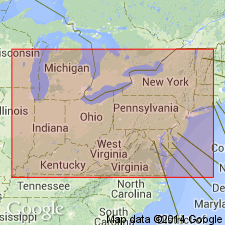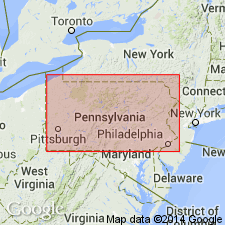
- Usage in publication:
-
- Bald Hill Bentonite Beds
- Modifications:
-
- Named
- Dominant lithology:
-
- Bentonite
- Shale
- Clay
- AAPG geologic province:
-
- Appalachian basin
Summary:
Bald Hill Bentonite Beds, here named in central PA, consist of three Early Devonian beds of pyroclastic origin within the Helderberg Group designated A, B, C. Bed A (oldest) is presumably equivalent to Rickard's (1962) Kalkberg bentonite in NY. At the type section in Blair Co., PA, and at New Creek, WV, Beds A and B occur within the New Scotland Formation, while C occurs near the base of the overlying Mandata. In MD Beds A and B are assigned to the Corriganville Limestone, an equivalent of the New Scotland, and C to the Mandata. At Cherryville, NY, all three beds occur within the middle member of the Kalkberg Limestone. The unit has also been identified at Monterey, VA, but formation assignment is not stated. At the type section, Bald Hill Bentonite Bed A consists of two parts, a lower 2- to 3-cm-thick pale-yellowish-brown clay shale and an upper 2- to 3-cm-thick soapy-feeling, dark yellowish-orange clay. Bed B is a 1- to 2-cm-thick, dark-yellowish-brown to very pale orange, soapy-feeling clay, located 2.10 m above the top of A. Bed C consists of 12 mm of grayish black to brownish black biotitic siltstone, located 80 cm above the top of B. Deposition is believed to have occurred in subtidal or deeper water, representing deep ramp and basin transgressional settings.
Source: GNU records (USGS DDS-6; Reston GNULEX).

- Usage in publication:
-
- Bald Hill Bentonites
- Modifications:
-
- Overview
- AAPG geologic province:
-
- Appalachian basin
Summary:
At the type locality of the Lower Devonian Bald Hill Bentonites in Blair Co., south-central PA, bentonites A and B both occur in the Corriganville Limestone. Bentonite C is in the overlying Mandata Shale. Smith and Berkheiser (1992: GSA Abs, NE section) also identified the three bentonites at Black Oak Ridge, Bedford Co., PA, approximately 40 km south-southwest of Bald Hill. Here Bald Hill Bentonite A is a 2.5 cm thick grayish yellow waxy claystone in the Corriganville Limestone and is 58 cm below bentonite B, a 1-cm-thick olive-gray waxy mudstone. Bentonite B is located at the Corriganville Limestone-Mandata Shale boundary at Black Oak Ridge, while at the type section, B occurs 42 cm below the boundary. The top of the Corriganville is therefore not isochronous, as suggested by Goodwin and Anderson (1985: Journal of Geology, v. 93, p. 515-533). Bentonite C occurs only 18 cm above the boundary and consists of less than 1 cm of olive-black biotitic mudstone.
Source: GNU records (USGS DDS-6; Reston GNULEX).
For more information, please contact Nancy Stamm, Geologic Names Committee Secretary.
Asterisk (*) indicates published by U.S. Geological Survey authors.
"No current usage" (†) implies that a name has been abandoned or has fallen into disuse. Former usage and, if known, replacement name given in parentheses ( ).
Slash (/) indicates name conflicts with nomenclatural guidelines (CSN, 1933; ACSN, 1961, 1970; NACSN, 1983, 2005, 2021). May be explained within brackets ([ ]).

